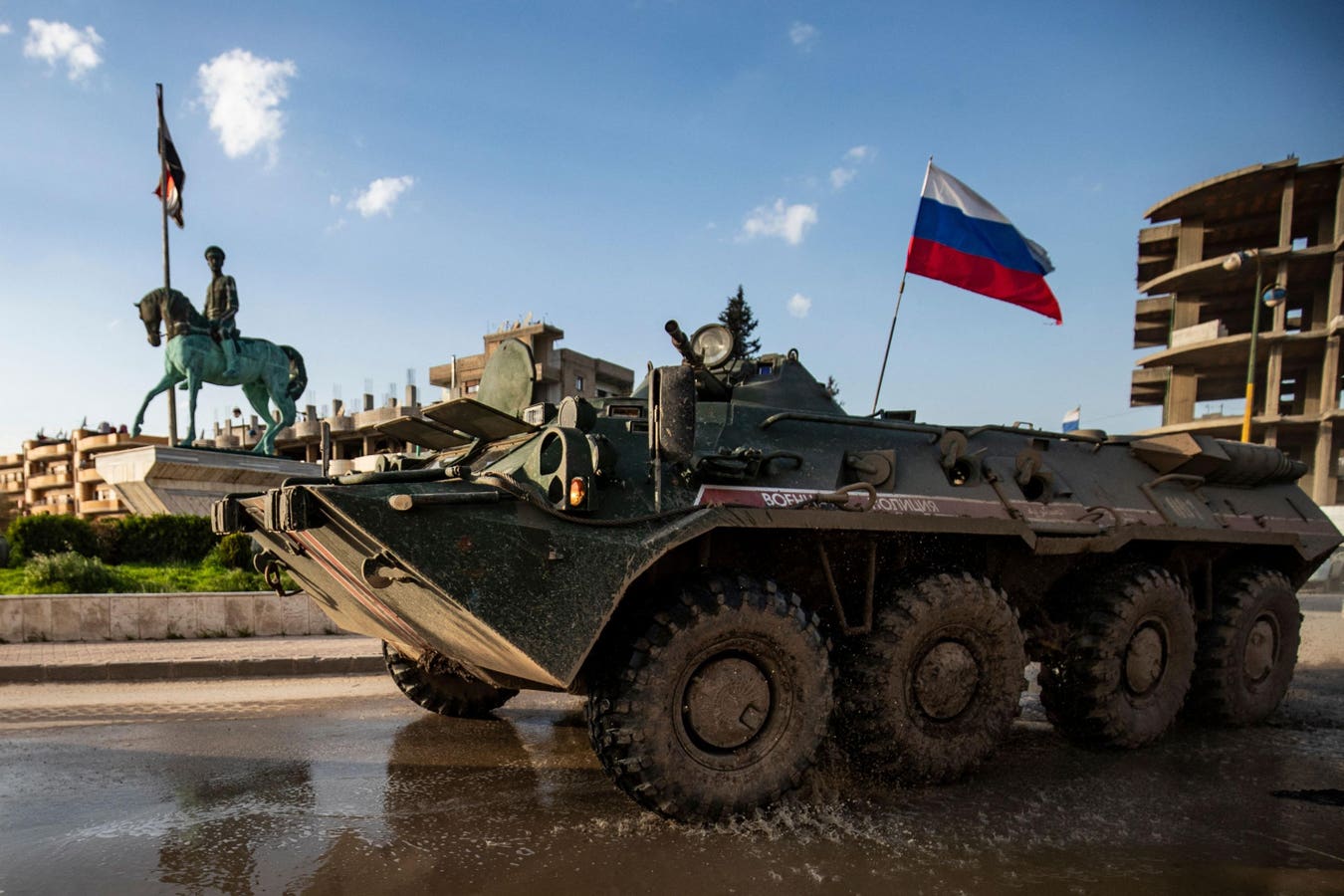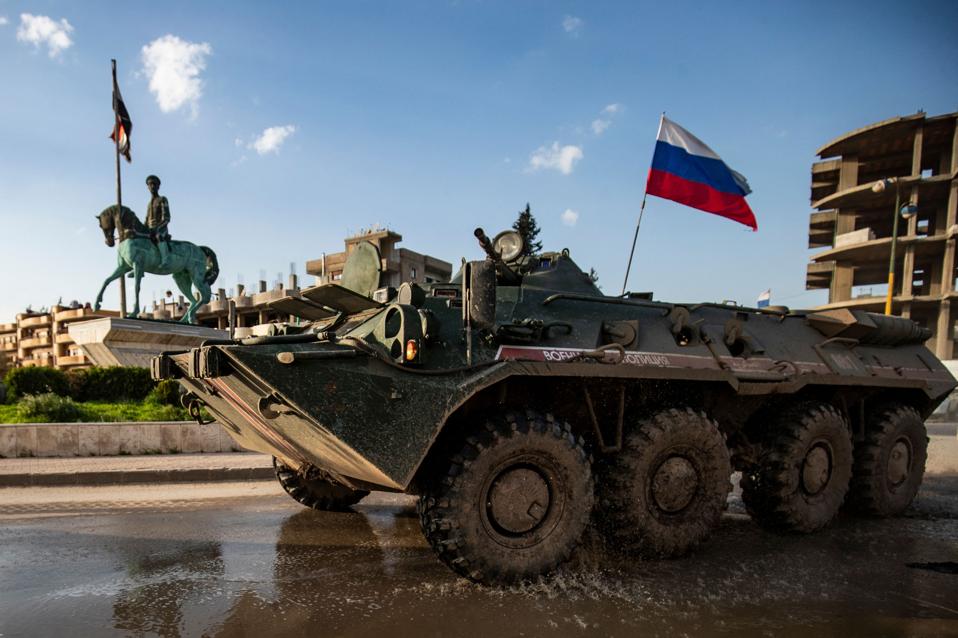A Russian military police armoured infantry vehicle (IFV) returning from a joint patrol with Turkish forces along the Syrian-Turkish border, drives along a roundabout near Qamishli airport in the northeastern Syrian city on April 9, 2020. (Photo by DELIL SOULEIMAN/AFP via Getty Images)
AFP via Getty Images
Following the dramatic fall of its ally, President Bashar al-Assad, in December 2024, the future of the Russian military presence in Syria looked bleak. Just under nine months on, Moscow still retains a military presence in Syria on the country’s western coast and has taken steps suggesting it seeks a continued presence in the northeast too.
In a report published this month, the Arabic-language Syria TV revealed that the Russian military has taken steps to strengthen its presence in Northeast Syria’s Qamsihli Airport. In recent weeks, it has reportedly expanded accommodations for troops, fortified the base’s perimeter, and raised the Russian flag, all indications that suggest it doesn’t intend on leaving any time soon. Russian cargo planes make regular flights transporting troops and equipment between Qamishli and Hmeimim Airbase in Syria’s western coastal Latakia province, Moscow’s main airbase in the country.
“These operations often take place at dawn or at night to avoid attracting attention and media coverage of their movements in the area,” the report claimed.
In addition to its small troop presence and armored vehicles, the Russians are believed to have Ka-52 attack helicopters stationed at the airport. Furthermore, Russia previously reinforced its presence at Qamishli following Assad’s December fall by deploying medium-range Pantsir-S1 air defense systems and electronic warfare units.
A Russian Air Force Kamov Ka-52 Alligator military attack helicopter is pictured with other trucks and vehicles at the Russian airbase at Qamishli Airport in northeastern Syria on December 12, 2024. (Photo by DELIL SOULEIMAN/AFP via Getty Images)
AFP via Getty Images
“Despite the collapse of the Assad regime, Russia has maintained a continuous presence in Qamishli,” Anton Mardasov, an associate fellow at the Middle East Institute and Russian military affairs expert, told me.
“The Russian military evacuated some military equipment to Libya by transport aircraft using this facility’s airstrip,” he said. “However, it’s clear that the base is poorly defended. For example, it would be difficult to relocate fighter jets there.”
Unlike Hmeimim, Qamishli doesn’t host fighter jets or cargo planes. In October 2021, at least one Su-35 Flanker fighter visited the airport for the first time. However, no buildup of fighter jets or any permanent deployment ensued.
“To this end, caponiers must be built, the perimeter must be expanded, and, most importantly, an echeloned air defense must be deployed,” Mardasov said. “The radars of this defense system will scan not only the sensitive southeastern zone of Turkey, but also part of Iraqi territory.”
The latest Syria TV report about Russian activities at Qamishli coincides with heightened tensions between the Kurdish-led Syrian Democratic Forces, which controls much of the broader northeastern region, and the new caretaker government in Damascus. For example, recent clashes in Aleppo killed a Syrian soldier.
Syria’s incumbent president, Ahmed al-Sharaa, previously headed the Islamist opposition Hayat Tahrir al-Sham armed group that spearheaded Assad’s overthrow. Today, Sharaa demands that the SDF disarm and allow the government’s forces to establish complete control over the northeastern and eastern regions currently controlled and administered by the SDF and its affiliated civilian Democratic Autonomous Administration of North and East Syria. The SDF and AANES seek a decentralized Syria.
Russia previously bombed HTS’s northwestern Idlib stronghold in support of Assad during the civil war. Since December, Moscow has sought ties with the new government in a bid to preserve its strategic military bases there, especially the Tartus naval base.
Kyle Orton, an independent Middle East analyst, believes the Syria TV report could be accurate, reasoning that it would make sense for the Russian military to bolster its presence there, given its “precarious position” at Hmeimim. However, he sees no information suggesting that the present Russian activity at Qamishli is little more than force-protection measures.
“The timing of the report, as the Syrian government signals that it is losing patience with diplomacy and will soon initiate a military operation against the SDF, cannot be ignored,” Orton told me. “During the civil war, the Russian—and Iranian—presence at the Qamishli Airport was probably the most visible symbol of the SDF keeping open relations with the pro-Assad coalition.
“After the fall of the regime, it has served pretty much the same purpose, to give the SDF options as the Americans head for the exit.”
Furthermore, it could prove “politically advantageous” for Sharaa’s government, which recently gained President Trump’s support, to highlight the SDF’s Russian links to “blunt any American outcry” that may follow an armed confrontation between Damascus and the SDF.
“That said, if the SDF are thinking along these lines, they are likely to be disappointed,” Orton said. “The Russians have never been able actually to do very much in Syria, and they are even less able now, especially if Turkey backs Sharaa’s government in an offensive against the ‘Autonomous Administration.’”
Still, the Russian military at Qamishli could potentially play a mediator role if Damascus-SDF tensions escalate.
“The Pantsirs provide minimal protection for the facility, which is primarily intended for flag displays and organizing ground patrols covered by helicopters,” Mardasov said.
“Therefore, it is logical that Moscow is maintaining and strengthening its presence there, planning to play some kind of mediator role between the SDF and Damascus, apparently with the latter’s consent.”
Orton pointed out that Russia has invariably kept contact with all sides in Syria to position itself as a mediator and power broker since intervening in Syria in 2015, giving itself the illusion of power in the war-torn country. Despite Assad’s ouster, Russia maintains this approach.
“While keeping the lines open with the SDF, Russia has been negotiating in various ways with Damascus over Hmeimim specifically and by implication Qamishli—an additional reason Moscow is unlikely to even really try to assist the SDF if and when Damascus comes to conquer the northeast,” he said.
“Russia joining in a losing SDF effort to hold its territory ensures Qamishli and probably Hmeimim are lost; standing aside as Damascus comes in might well be the quid for the quo of Sharaa signing off on the Russians keeping their bases.”
Syrian Foreign Minister Asaad al-Shaibani has reportedly requested that Russian military police in Syria deploy to southern Syria to act as a buffer and mediator with Israel, which has expanded its military presence in that area since December.
Orton doesn’t believe this is “completely out of the blue,” noting that Sharaa has used the possibility of playing the ‘Russian card’ as leverage in negotiations with the United States.
“Since Trump’s only real interest is Sharaa preventing an Afghan-style meltdown during the U.S. withdrawal, it has left a lot of scope for Damascus to have it both ways—securing American support, and testing out what it can get from the Russians, who plan to stay after the Americans are gone,” he said.
Consequently, it seems plausible that Russia has decided that its best bet to preserve its military footprint in Syria is to work with Damascus, especially since the SDF’s future may not prove sustainable after a U.S. withdrawal.
Moscow has likely concluded it’s better off reaching terms with Sharaa over basing rights and developing military and economic relations to “recover some of its political influence” in Damascus, especially if it has concluded he aims to become the master of all Syria.
“The wildcard is what this means for Iran’s influence in Syria, given how integrally the Russian position in the country has been tied to the Iranians,” he said.
“It does not seem accidental that the reports—murky as they are—of IRGC (Iran’s powerful paramilitary Islamic Revolutionary Guard Corps) activities in Syria since Assad’s demise have concentrated on the coast and around Qamishli, in those places where Russia still has a footprint.”

